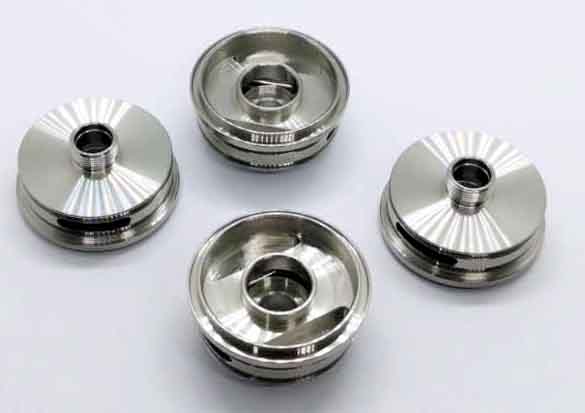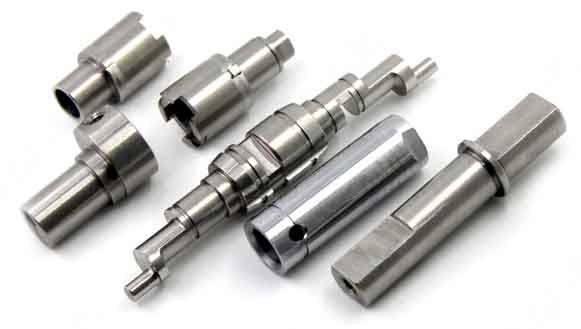Denne artikel analyserer procesindstillingerne for drejning af hærdet stål, høj temperatur legering, titanlegering, afkølet støbejern, og termiske spraymaterialedele. Og egenskaberne ved disse svære at skære materialer, skære mængder, vende væsker, og drejeværktøj.
Drejeteknologi af hærdet stål
1. Turning of hardened steel:
① Cutting characteristics of hardened steel:
1) High hardness: HRC45-70.
2) High brittleness.
3) High strength: σb = 2100~2600 MPa, som handler om 4 times that of 45 stål.
4) Large cutting force: The unit cutting force Kc is 4500MPa, which is 2.5 times that of 45 stål.
5) High cutting temperature: its thermal conductivity is 1/7 af 45 stål.

Drejeteknologi af hærdet stål
② Turning tool and cutting amount of hardened steel:
1) Tool materials: PCBN, ceramics, cementeret hårdmetal (600, 610, YS8, YT05, 758, 813), etc.
2) Tool geometry parameters: γ0=0~-10°, workpiece hardness and continuous cutting γ0=-10~-30°, α0=8~10°, κr=30~60°, λs=0~-3° .
3) Cutting amount: cemented carbide Vc=30~50m/min; Ceramic tool Vc=60~120m/min; PCBN tool Vc=100~200 m/min, Vc is 1/2 of the above during intermittent turning, and αp and f are 1/2 of general steel.
Note: Generelt, the heat resistance of quenched steel is 200~400℃, and its hardness decreases with increasing temperature. The heat resistance of tool materials (hard alloys, ceramics, PCBN) are respectively 800~1000℃, 1200℃, 1400~1500℃, using this feature, in continuous cutting, Vc cannot be selected too low; When drilling, Vc should be reasonable, and the tool should be retracted; During continuous cutting, f should be small, κr bør reduceres passende, γε steget, og λs skal være negativ.
Drejeteknologi af superlegering

Drejeteknologi af superlegering
2. Drejning af superlegering
Fordi højtemperaturlegeringen indeholder mange legeringselementer med højt smeltepunkt Fe, Af, Cr, I, V, W, Mo og så videre. Dette element og andre legeringselementer danner en austenitisk legering med høj renhed og tæt struktur. De indeholdte grundstoffer og de ikke-metalliske grundstoffer C, B, N, etc. danner metal- og ikke-metalforbindelser med høj hårdhed, lav vægtfylde, og højt smeltepunkt. Gør anden bearbejdelighed meget dårlig. Dens relative drejningsbearbejdelighed er kun 5-20% af 45 stål.
① Drejeegenskaber for superlegering:
1) Large cutting force: 2 til 3 gange større end at skære almindeligt stål.
2) High cutting temperature: 50% højere end skæring 45 stål.
3) Alvorlig arbejdshærdning: hårdheden af skærefladen og den bearbejdede overflade er 50-100% højere end matrixens.
4) Tools are easy to wear: adhesion, diffusion, oxidation, and groove wear are easy to occur.
②Materials for turning tools of high-temperature alloys:
1) High-speed steel: High-speed steel containing high vanadium, high carbon and aluminum should be used.
2) Cemented carbide: fine and ultrafine particles of YG should be used
③ Geometric parameters of turning tools for high-temperature alloys:
Deformed superalloy: γ0=10°, cast superalloy: γ0=0°, generally do not take negative chamfering. α0=10~15°, rough turning λs =-10°, fine turning λs=0~3°, κr=45~75°.
④ Turning amount of superalloy:
1) High-speed steel cutter: Vc=3~8m/min.
2) Carbide tool: Vc=10~60 m/min. Deformed superalloy: Vc=40~60m/min. Casting high-temperature alloy: Vc=7~10m/min. αp and f>0.1mm.
⑤ Skærevæske til højtemperaturlegeringer: det samme som rustfrit stål.
⑥ Boring af højtemperaturlegeringer: Hårdmetalbor eller bor af S-type og lavt hul bør så vidt muligt anvendes; For eksempel, ved brug af en højhastighedsstålboremaskine, øge størrelsen af 2 ledninger, male α0 og b, Vc is 3 m/min, og f er 0,2–0,3 mm/r; Boret skal være skarpt, og standarden for afstumpethed er 1/2 til 1/3 af det almindelige stål. Det er bedst at bruge automatisk foder, stop ikke på skærefladen.

Drejeteknologi af titanium dele
Drejeteknologi af titanium dele
3. Drejning af titanlegering:
Titanium legering er et nyt metal udviklet i de seneste årtier. På grund af dens høje specifikke styrke (σb/ρ=1680/4,5=373, 4.5 times that of 45 stål), høj termisk styrke (langtidsarbejde ved 500 ℃), god korrosionsbestandighed, og fremragende ydeevne ved lav temperatur, det bruges i rumfart, chemical engineering , Medical treatment, etc.
① Cutting characteristics of titanium:
1) The cutting temperature of titanium is high: under the same cutting conditions, it is twice as high as cutting 45 stål.
2) Titanium has a great affinity and serious bonding, which will cause bonding at high temperatures.
3) Titanium has high chemical activity: under high temperature cutting conditions, it reacts with O, N, H, C in the air to form a hard skin layer of TiO2, TiN, TiH, etc., which brings difficulties to cutting.
② Tool materials for turning titanium:
1) High-speed steel: In addition to ordinary high-speed steel, it is best to use high-vanadium, high-cobalt, and aluminum-containing high-speed steel.
2) Cemented carbide: YG8, YG6X, YG6A, 813, 643, YS27, YD15.3) PCD, PCBN natural diamond.
③ Tool geometry parameters: γ0=5~15°, α0≥15°.
④ Turning amount of titanium:
1) High-speed steel cutter: Vc=8~12 m/min.
2) Cemented carbide tools: Vc=15~60 m/min.
3) PCD, PCBN natural diamond tools: wet cutting Vc=200 m/min
Dry cutting Vc=100 m/min, αp>0.05mm, f>0.05mm/r.
⑤ Titanium cutting fluid: Emulsion and extreme pressure emulsion are used for one. Extreme pressure cutting oil is used for finishing.
⑥ Note for turning titanium:
When turning a slender shaft (stang), the live center and nylon should be used as the claw holder of the tool holder and the center frame; When reaming, use castor oil 60% + kerosene 40% as cutting fluid; When tapping, appropriately increase the diameter of the bottom hole.
4. Turning of chilled cast iron:
The surface layer of the cast iron is white mouthed, and the hardness can reach about HRC60; The unit cutting force K c can reach 3000 MPa, which is 1.5 times that of cutting 45 stål; The cutting force is concentrated near the cutting edge, and there are pores and sand in the machining, which can easily damage the tool during cutting;
Its brittleness is large, and the phenomenon of edge chipping and slag falling will occur during cutting.
① Tool material for turning cast iron:
1) Cemented carbide: a cemented carbide with high hardness and bending strength should be selected. Såsom: YS2, YS8, YS10, 600, 610, 726.
2) Ceramics: SG4, AT6, SM, FT80, FT85.
3) PCBN: used for fine turning.
② The geometric parameters of the tool for turning cast iron: 1) Carbide: γ0=0~-5°, α0=5~10°, κr≤45°(κr=45°), λs =-5~一10°, γε =0.5~1 mm;
③ The amount of cutting cast iron:
1) Carbide tool: rough machining Vc=7~10m/min, αp=5~10mm, f=0.5~1.5mm/r. Finishing: Vc=15~20m/min, αp=0.5~2mm, f=0.3~0.5mm/r.
2) Ceramic tools: Vc=40~50m/min, αp=0.5~2mm, f=0.3~0.6mm/r.
3) PCBN cutter: Vc=60~70m/min, αp=0.5~2mm, f=0.1~0.3mm/r.
5. Turning of thermal spraying (svejsning) materialer:
Thermal spraying materials are mostly multi-component high-strength alloys. After high temperature and high speed spraying on the surface of the workpiece, the hardness, korrosionsbestandighed, wear resistance and heat resistance of the surface of the workpiece are greatly improved, and it is widely used. The hardness of the copper-based and iron-based powder spray coating is easier to cut. The hardness of the cobalt-based and nickel-based powder spray coating is >HRC50, which is difficult to cut. Cobalt-clad WC, nickel-clad WC, and nickel-clad Al2O3 spray coatings have hardness> HRC65, which is the most difficult to cut.
① Tool materials for turning thermal spraying materials:
1) Cemented carbide: hårdhed>HRC45, using YG, YW cemented carbide;
Hardness, using 600, 610, 726, 767, YD05, YC12, YS2, YS8;
Hardness>HRC65, brug YG3X, YD05, YC09, YC12, YS8, 600, 610.
2) Keramisk skærer: 3) PCBN
② Værktøjets geometriske parametre ved drejning af termiske spraymaterialer: γ0=0~-5°, α0=8~12°, κr≤45°.
③ Mængden af skærende termisk sprøjtemateriale: cementeret hårdmetal Vc=6~40m/min;
Keramisk skærer Vc=18~80m/min;
PCBN værktøj: Vc=24~160m/min. αp=0,15~0,6mm; f=0,1–1 mm/r.
 English
English العربية
العربية 中文(漢字)
中文(漢字) Čeština
Čeština Dansk
Dansk Nederlands
Nederlands Suomi
Suomi Français
Français Deutsch
Deutsch Italiano
Italiano 日本語
日本語 ಕನ್ನಡ
ಕನ್ನಡ 한국어
한국어 Português
Português Русский
Русский Slovenčina
Slovenčina Español
Español Svenska
Svenska Türkçe
Türkçe

